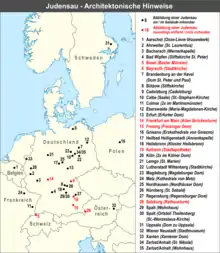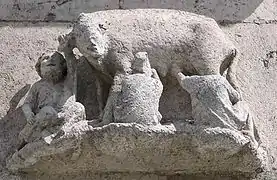Judensau
A Judensau (German for "Jews' sow"[1])[2][3] is a folk art[4] image of Jews in obscene contact with a large sow (female pig), which in Judaism is an unclean animal, that appeared during the 13th century in Germany[1] and some other European countries; its popularity lasted for over 600 years.[5]
| Part of a series on |
| Antisemitism |
|---|
 |
|
|
Background and images

The Jewish prohibition against eating pork comes from Torah, in the Book of Leviticus Chapter 11, verses 2 through 8.[6][7] The arrangement of Jews surrounding, suckling, and having intercourse with the animal (sometimes regarded as the devil[4]), is a mockery of Judaism.
The image appears in the Middle Ages, mostly in carvings on church or cathedral walls,[1] often outside where it could be seen from the street (for example at Wittenberg and Regensburg), but also in other forms. The earliest appearance seems to be on the underside of a wooden choir-stall seat in Cologne Cathedral, dating to about 1210. The earliest example in stone dates to ca. 1230 and is located in the cloister of the cathedral at Brandenburg. In about 1470 the image appeared in woodcut form, and thereafter was often copied in popular prints, often with antisemitic commentary. A wall painting on the bridge tower of Frankfurt am Main, constructed between 1475 and 1507 near the gateway to the Jewish ghetto and demolished in 1801, was an especially notorious example and included a scene of the ritual murder of Simon of Trent.[8]
Judensau in Wittenberg

The city of Wittenberg contains a Judensau from 1305, on the façade of the Stadtkirche, the church where Martin Luther preached. It portrays a rabbi who looks under the sow's tail, and other Jews drinking from its teats. An inscription reads "Rabini Schem HaMphoras", gibberish which presumably bastardizes "Shem HaMephorash". The sculpture is one of the last remaining examples in Germany of medieval "Jew baiting". In 1988, on the occasion of the 50th anniversary of the Kristallnacht, debate sprung up about the monument, which resulted in the addition of a sculpture recognizing that during the Holocaust six million Jews were murdered "under the sign of the cross".[9]
In Vom Schem Hamphoras (1543), Luther comments on the Judensau sculpture at Wittenberg, echoing the antisemitism of the image and locating the Talmud in the sow's bowels:
Here on our church in Wittenberg a sow is sculpted in stone. Young pigs and Jews lie suckling under her. Behind the sow a rabbi is bent over the sow, lifting up her right leg, holding her tail high and looking intensely under her tail and into her Talmud, as though he were reading something acute or extraordinary, which is certainly where they get their Shemhamphoras.[2]
In July 2016, Dr. Richard Harvey, a Messianic Jewish (Christian) theologian from the United Kingdom, initiated a petition on Change.org to have the Wittenberg Judensau removed.[10]
In 2018, Michael Düllmann, a member of Berlin's Jewish community, sued to have the sculpture removed as defamatory. As of February 2020, the district court of Dessau and the Higher Regional Court in Naumburg had rejected the claim, though petitioner vowed to appeal to higher courts. The Lutheran church and some historians, such as Michael Wolffsohn, have also debated whether the sculpture should be removed for being antisemitic or whether doing so would whitewash the church's historical antisemitism.[11]
Partial list

Some of these sculptures can be found at some churches today.
- Aarschot in Belgium (Our Lady Church)
- Basel in Switzerland (Cathedral)
- Brandenburg (Cathedral)
- Cadolzburg
- Colmar in France at (Église Saint-Martin – 2 representations)
- Cologne (Judensau at the choir stalls of Cathedral – probably the earliest example, and in Church of St. Severin)
- Eberswalde
- Erfurt (Cathedral)
- Heilsbronn (Cathedral)
- Gniezno (Cathedral)
- Lemgo (St. Marien)
- Magdeburg (Cathedral)
- Metz in France (Cathedral)
- Nuremberg (St. Sebaldus Church)
- Regensburg (Cathedral)
- Remagen (Gate post)
- Strasbourg (Cathedral, on capital)
- Uppsala in Sweden (Cathedral)
- Wiener Neustadt in Austria
- Wimpfen (Church of St. Peter)
- Wittenberg (Town church)
- Xanten (Cathedral)
- Zerbst (St. Nicolas Church)
Image gallery
.jpg.webp) Judensau at the Cathedral of Brandenburg
Judensau at the Cathedral of Brandenburg Judensau on the Cathedral of St. Martin in Colmar
Judensau on the Cathedral of St. Martin in Colmar Judensau on the Cathedral in Heilsbronn
Judensau on the Cathedral in Heilsbronn Judensau at the Cathedral of St. Peter in Regensburg
Judensau at the Cathedral of St. Peter in Regensburg Judensau at the minster in Wimpfen
Judensau at the minster in Wimpfen Judensau on the Wittenberg Parish Church, cited by Luther
Judensau on the Wittenberg Parish Church, cited by Luther Woodcut of the Bridge Tower at Frankfurt, showing martyrdom of Simon of Trent above a Judensau
Woodcut of the Bridge Tower at Frankfurt, showing martyrdom of Simon of Trent above a Judensau Illustration from an antisemitic book (Aarau 1822)
Illustration from an antisemitic book (Aarau 1822)
See also
References
- "The Judensau (Jews' sow) on mediaeval churches". concordatwatch.eu. Retrieved 7 February 2015.
- Wolffsohn, Michael (1993). Eternal Guilt?: Forty Years of German-Jewish-Israeli Relations. Columbia University Press. p. 194. ISBN 978-0-231-08275-4.
- Shachar, Isaiah (1974). The Judensau : a medieval anti-Jewish motif and its history. Warburg Institute, University of London. ISBN 0854810498.
- "Zionism and Israel - Encyclopedic Dictionary: Judensau". zionism-israel.com. Retrieved 7 February 2015.
- Madigan, Kevin (2005). "Judensau". In Richard S. Levy (ed.). Antisemitism: a Historical Encyclopedia of Prejudice and Persecution. Vol 1: A-K. ABC-CLIO. pp. 387–88. ISBN 978-1-85109-439-4.
- Authorized King James Bible. 1611. Retrieved 7 February 2015.
Speak unto the children of Israel, saying, These [are] the beasts which ye shall eat among all the beasts that [are] on the earth. Whatsoever parteth the hoof, and is clovenfooted, [and] cheweth the cud, among the beasts, that shall ye eat. Nevertheless these shall ye not eat of them that chew the cud, or of them that divide the hoof: [as] the camel, because he cheweth the cud, but divideth not the hoof; he [is] unclean unto you. And the coney, because he cheweth the cud, but divideth not the hoof; he [is] unclean unto you. And the hare, because he cheweth the cud, but divideth not the hoof; he [is] unclean unto you. And the swine, though he divide the hoof, and be clovenfooted, yet he cheweth not the cud; he [is] unclean to you. Of their flesh shall ye not eat, and their carcase shall ye not touch; they [are] unclean to you.
- "Leviticus - Chapter 11 (Parshah Semini) - Tanakh Online - Torah - Bible". chabad.org. Retrieved 7 February 2015.
- Schreckenburg, Heinz (1996). The Jews in Christian Art. New York: Continuum. pp. 331-337, Cologne illustrated p. 332, Frankfurt pp. 335-7. ISBN 0-8264-0936-9.
- Lopez, Billie; Peter Hirsch (1997). Traveler's Guide to Jewish Germany. Pelican Publishing Company. pp. 258–60. ISBN 978-1-56554-254-9.
- Nitz, Corinna. "Evangelische Akademie: Kritiker von Schmähplastik "Judensau" kommt nach Wittenberg". mz-web.de (in German).
- Aaron Labaree (February 8, 2020). "A German Jew Vows To Fight On To Remove Anti-Semitic Sculpture After Court Defeat". NPR. Retrieved 2020-02-08.